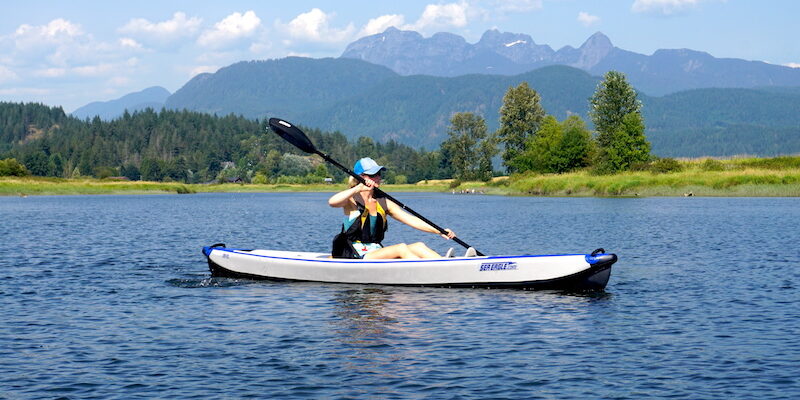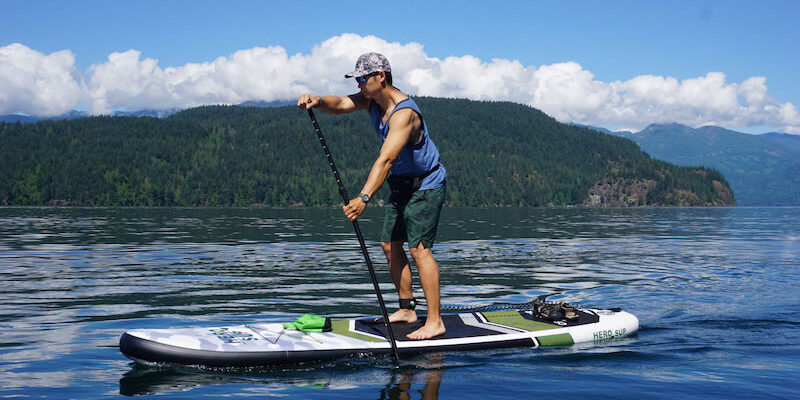The kayak was first used and developed by the indigenous Inuit people and used to hunt on lakes, rivers and coastal waters.
They were made from seal or other animal skins stretched over a wood or whalebone-skeleton frame.
These small boats were human powered and made to fit one to three people each using a double bladed paddle.
Kayaks have made some major advancements in design and use over time. Today there are three main classifications of kayaks that are constructed and used by people all over the world:
- rigid kayaks
- folding kayaks
- inflatable kayaks
Within these three main classifications there are sub-classifications which include whitewater kayaks, ocean kayaks, recreational kayaks, fishing kayaks, sit-on-top kayaks, as well as a few others.
Below we will take a look at the three main classifications and get a better understanding of what they are and how they differ from each other.
Rigid Kayaks
Rigid kayaks are the most well known and are typically made of plastic, fibreglass, wood, carbon fiber or Kevlar.
- Plastic – The Plastic kayaks are often priced quite cheap and therefore very affordable for those who want to purchase a kayak to try out the sport and see if they like it or for those who do not plan to use it often and therefore do not want to invest a lot of money. They are tough and can take a good amount of abuse but repairs are not that easy and they are often not as comfortable as the higher priced models made of other materials.
- Fiberglass – The Fiberglass kayaks are usually lighter in weight as well as better in quality and higher in price than the plastic kayaks. They are designed for the serious paddler who wants a good kayak for a decent price. These kayaks can get damaged more easily than the plastic models but they are also a lot easier to repair.
- Carbon Fiber – Carbon fiber kayaks cost more money and are very light weight. They will appeal to those who want a very good quality kayak that is light enough to easily transport and carry. However one thing to be very aware of with carbon is that it can shatter easily and therefore repairs could be needed often.
- Kevlar – Kayaks made of Kevlar are normally high quality and well made. They are extremely light – even lighter than the carbon and fibreglass models and consequently cost a lot more money. These will appeal to the very well experienced and serious paddler looking for a top of the line model that will offer excellent performance and ease of use. Kevlar is the same material used in bulletproof vests which are used by military branches and police forces… very tough and very light weight.
- Wood – Wood kayaks are in a league all of their own. Their craftsmanship and beauty will depend on who is constructing it. Some are very well made while others are not. The quality, weight and price can differ greatly. They tend to be easily repairable and require very little maintenance.
Folding Kayaks
Folding kayaks have a collapsible frame usually made of aluminum, plastic, wood, or a combination thereof. The frame is covered by a water-resistant and durable fabric.
Some types of folding kayaks have inflatable material and others have air built into the hull which makes the kayak float even if it is flooded with water.
Folding kayaks are typically well made, very durable and often more expensive than a regular rigid kayak.
They are ideal for those who want a good quality kayak that is portable enough to bring anywhere and easy to store away.
The one negative is that they often take at least 20 minutes to set up.
Inflatable Kayaks
Inflatable kayaks are extremely portable and can usually be carried in a bag or a backpack. They are perfect for those who have limited storage space and want to travel with their kayak.
They are made with either PVC, hypalon, or Nitrylon. Inflatable kayaks have come a long way over the years. Originally known as “duckies” they are now so well made that they are used by the US Coast Guard in many of their rescues.
Their tough construction and durable material means they do not dent and are able to withstand a fair amount of abuse.
Prices can vary greatly as can quality and performance. Each year there are more and more well made inflatable kayaks on the market.
Their popularity is gaining as more people look for easy and convenient ways to get out and enjoy the water.
They tend to be very stable and for this reason are great for beginner paddlers and people of all ages.
Learn more great paddling tips and advice.


Leave a Reply Cancel reply